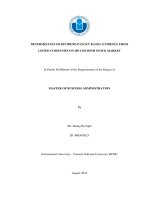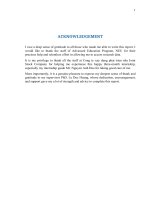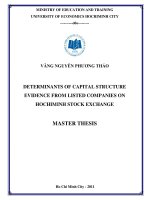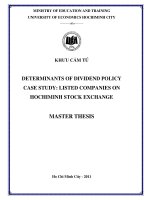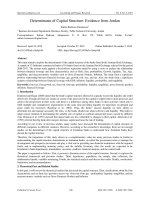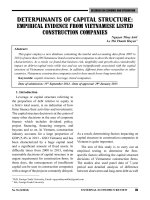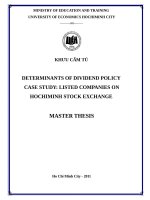Determinants of capital structure evidence from listed companies on hochiminh stock exchange
Bạn đang xem bản rút gọn của tài liệu. Xem và tải ngay bản đầy đủ của tài liệu tại đây (833.33 KB, 104 trang )
MINISTRY OF EDUCATION AND TRAINING
UNIVERSITY OF ECONOMICS HOCHIMINH CITY
----------o0o---------
VĂNG NGUYỄN PHƯƠNG THẢO
DETERMINANTS OF CAPITAL STRUCTURE
EVIDENCE FROM LISTED COMPANIES ON
HOCHIMINH STOCK EXCHANGE
MASTER THESIS
Ho Chi Minh City - 2011
MINISTRY OF EDUCATION AND TRAINING
UNIVERSITY OF ECONOMICS HOCHIMINH CITY
----------o0o---------
VĂNG NGUYỄN PHƯƠNG THẢO
DETERMINANTS OF CAPITAL STRUCTURE
EVIDENCE FROM LISTED COMPANIES ON
HOCHIMINH STOCK EXCHANGE
MAJOR: BANKING AND FINANCE
MAJOR CODE : 60.31.12
MASTER THESIS
INSTRUCTOR : ASSOC. PROF. – DR. PHẠM VĂN NĂNG
Ho Chi Minh City - 2011
ACKNOWLEDGEMENT
I would like to express my deepest gratitude to my research Instructor,
Associate Professor – Doctor Pham Van Nang for his intensive support, valuable
suggestions, guidance and encouragement during the course of my study.
My sincere gratitude are also due to Doctor Vo Xuan Vinh for his valuable
feedback on the problems of the study.
I would like to express my thanks to all of my lecturers at Banking and
Finance Faculty, University of Economics Hochiminh City for their teaching and
guidance during my Master of Banking and Finance course.
Moreover, I would like to specially express my thanks to all of my
classmates, my friends for their support and encouragement.
My final and greatest thanks are sent to my family including my parents, my
brothers, my husband and my baby who are the greatest encouragement for me to
overcome all difficulties in my life.
i
ABSTRACT
This thesis research the explanatory power of some of the literary theories
that have been propounded to explain variations in capital structures across firms.
In specific, this thesis investigates capital structure determinants of firms listed on
Hochiminh Stock Exchange based on a panel data set from 2006 to 2010
comprising 77 companies. Main characteristic of Vietnamese firms, including
firms listed on Hochiminh Stock Exchange, is short-term debt comprises a
considerable part of firms’ total debt. An analysis of determinants of leverage
based on total debt ratios may hide significant differences in the determinants of
long and short-term forms of debt. Therefore, this thesis studies determinants of
total debt ratios as well as determinants of short-term and long-term debt ratios.
The thesis consider the impact of those ratios on capital structure during period
2006-2010 to consider whether there was any different from before, in and after
the financial crisis. The thesis also tests the different choice of capital structure of
eleven groups of industries. And the last answer should be find out is the
difference of capital structure of firms with different size.
Keywords: Capital structure, Vietnam, HOSE.
ii
CONTENTS
Acknowledgement ......................................................................................... i
Abstract ................................................................................................ ii
Contents .......................................................................................................iii
List of Tables ............................................................................................... vi
Abbreviations .................................................................................................... vii
CHAPTER 1: INTRODUCTION ............................................................................ 1
1.1. Introduction ...................................................................................................... 1
1.2. Research objectives .......................................................................................... 2
1.3. Research methodology...................................................................................... 2
1.4. The structure of the research ............................................................................. 3
CHAPTER 2: LITERATURE REVIEW.................................................................. 5
2.1. Introduction ...................................................................................................... 5
2.2. Theoretical and Empirical Findings .................................................................. 5
2.3. Potential determinants of capital structure......................................................... 7
2.3.1. Profitability (PROF) ...................................................................................... 8
2.3.2. Firm size (SIZE) ............................................................................................ 9
2.3.3. Assets tangibility (TANG) ........................................................................... 10
2.3.4. Growth opportunities (GRO) ....................................................................... 10
2.3.5. Non-debt tax shield (NDTS) ........................................................................ 11
iii
2.3.6. Income variability (INVAR) ........................................................................ 12
2.3.7. Time dummies ............................................................................................. 12
2.3.8. Industry Dummies ....................................................................................... 13
2.4. Measures of capital structure/financial leverage .............................................. 13
2.4.1. Financial leverage of firms........................................................................... 13
2.4.2. Decomposition of total debt into short-term and long-term debt ratios ......... 16
2.5. Conclusion...................................................................................................... 19
CHAPTER 3: RESEARCH METHODOLOGY .................................................... 21
3.1. Introduction .................................................................................................... 21
3.2. Data specifications.......................................................................................... 21
3.2.1 Research sample description ......................................................................... 21
3.2.2. Explanatory variables .................................................................................. 22
3.2.3 Dependent variables...................................................................................... 22
3.3. Empirical model specifications ....................................................................... 22
3.3.1 Model 1 ........................................................................................................ 23
3.3.2 Model 2 ........................................................................................................ 24
3.3.3 Model 3 ........................................................................................................ 24
CHAPTER 4: DATA ANALYSIS AND FINDINGS ............................................ 26
iv
4.1 Introduction ..................................................................................................... 26
4.2 Descriptive statistics ........................................................................................ 26
4.3 Correlation matrix of explanatory variables ..................................................... 29
4.4 Results of Model 1........................................................................................... 30
4.5 Results of Model 2........................................................................................... 33
4.6 Results of Model 3........................................................................................... 35
4.7 Robustness tests............................................................................................... 38
CHAPTER 5: CONCLUSION .............................................................................. 42
5.1 Introduction ..................................................................................................... 42
5.2 Conclusion....................................................................................................... 42
5.3 Limitations ...................................................................................................... 44
5.4 Recommendations ........................................................................................... 45
References .................................................................................................. 47
Appendix A – Regression results of 3 models .............................................. 52
Appendix B – Research data set (2006 – 2010) ............................................ 76
v
LIST OF TABLES
Table 2.1. Short-term vs. long-term debt ..... ........................................................17
Table 2.2. Short-term debt ratios and firm sizes ....................................... .............19
Table 2.3. Long-term debt ratios and firm sizes ............................... ...................19
Table 3.1. Potential determinants of capital structure, corresponding measures,
and expected effect on financial leverage .......... .................................23
Table 4.1. Summary of the industry structure ..................................................... 27
Table 4.2. Descriptive statistics of the variables used in the study for the nonfinancial firms listed on HOSE for the period 2006 to 2010 ............... 28
Table 4.3. Comparative means for different size of firms ................................... 28
Table 4.4. Correlation coefficients among the explanatory variables .................. 29
Table 4.5. The reported results of Model 1 ..................................................... 31
Table 4.6. The reported results of Model 2 ........................................................ 34
Table 4.7. The reported results of Model 3 ........................................................ 36
Table 4.8. Results of Model 1 : Fixed Effects versus Random Effects ................ 39
Table 4.9. Results of Model 3 : Fixed Effects versus Random Effects ................ 41
vi
ABBREVIATIONS
HOSE
Hochiminh Stock Exchange
PROF
Profitability
SIZE
Firm size
TANG
Asset tangibility
GRO
Growth opportunities
NDTS
Non-debt tax shield
INVAR
Income variability
TDTA
Total debt to total assets
SDTA
Short-term debt to total assets
LDTA
Long-term debt to total assets
vii
Determinants of Capital Structure
CHAPTER 1: INTRODUCTION
1.1. Introduction
One of the tough challenges that firms face is the choice of capital structure.
Capital structure decision is important because it affects the financial performance
of the firm. The capital structure of a firm is defined by Abor J. (2005, p.438-45) as
specific mix of debt and equity that a firm uses to finance its operations.
The modern theory of capital structure was firstly established by Modigliani and
Miller (1958). Thirty-seven years later, Rajan and Zingales (1995, p. 1421) stated:
“Theory has clearly made some progress on the subject. We now understand the
most important departures from the Modigliani and Miller assumptions that make
capital structure relevant to a firm’s value. However, very little is known about the
empirical relevance of the different theories”. Similarly, Harris and Raviv (1991, p.
299) in their survey of capital structure theories claimed: “The models surveyed
have identified a large number of potential determinants of capital structure. The
empirical work so far has not, however, sorted out which of these are important in
various contexts.” Thus, several conditional theories of capital structure exist (none
is universal), but very little is known about their empirical relevance. Moreover, the
existing empirical evidence is based mainly on data from developed countries (G7
countries). Findings based on data from developing countries have not appeared
until recently – for example Booth et al. (2001) or Huang and Song (2002). So far,
no study has been published based on data from Vietnam (especially the
Hochiminh Stock Exchange (HOSE)), at least to the extent of this author’s
knowledge. The main goal of this thesis is to fill this gap, exploring the case of the
listed firms in HOSE.
The remainder of this
chapter
provides general introduction
about the
research objectives, research methodology and the structure of the research.
1
Determinants of Capital Structure
1.2. Research objectives
The research is planned in the context of firms listed on Hochiminh Stock
exchange of Vietnam. The purpose of this thesis is to empirically examine the link
between a number of potential capital structure determinants and debt measures for
non-financial Vietnamese firms listed on HOSE for the period of 2006-2010.
The purpose of this research is looking for answers to the following questions:
Q1.: How is financial leverage (total debt ratio, long-term debt ratio and short-term
debt ratio) of listed firms in Hochiminh Stock Exchange impacted by determinants
of capital structure (profitability, size, firm tangibility (asset structure), growth
opportunities, non-debt tax shield, and income variability)? Are these impacts
shifted over years?
Q2.: What are the effects of industry dummies on those impacts?
Q3.: Are the determinants different in firms of different size (small, medium and
large size)?
1.3. Research methodology
The research uses a firm-level panel data set of 77 publicly traded non-financial
firms on Hochiminh Stock Exchange between 2006 and 2010.
The empirical steps to examine the above mentioned research objectives
proceed as follows :
Descriptive statistics
Correlation matrix
Using random effects logistic regression model to test the determinants of
capital structure
2
Determinants of Capital Structure
Stata software version 11 is used as an data analysis tool to implement this
research.
1.4. The structure of the research
The structure of the study consist five chapters:
Chapter 1: Introduction
This chapter presents introduction of the thesis, as well as research objectives and
research methodology.
Chapter 2: Literature Review
A summary of the literature review is provided, including the potential
determinants of capital structure as well as some variables to explain the reasons
for firms to choose debt measures.
Chapter 3: Research Methodology
Based on the research objectives, research methodology concerned in chapter 1,
and literature review presented in chapter 2, this chapter particularly presents the
data and empirical model specifications.
Chapter 4: Data Analysis and Findings
Chapter 4 presents the analysis of results from the study. We use descriptive
statistics to explore the features of explanatory variables and correlation matrix to
present the relationship between explanatory variables. Furthermore, we use
regression analysis to explore the impacts of debt measures on the determinants of
the capital structure of listed firms on Hochiminh Stock Exchange.
Chapter 5: Conclusions
3
Determinants of Capital Structure
Chapter 5 presents main conclusions and the limitations of this thesis. From the
results of the previous chapters as well as those limitations, some recommendations
are suggested by the author.
4
Determinants of Capital Structure
CHAPTER 2: LITERATURE REVIEW
2.1. Introduction
In this chapter, a summary of the literature review is provided, including the
potential determinants of capital structure as well as some variables to explain the
reasons for firms to choose debt measures. The purpose of this review is to provide
the background for the research hypotheses.
2.2. Theoretical and Empirical Findings
According to Myers (2001, p. 81), “there is no universal theory of the debt-equity
choice, and no reason to expect one”. However, there are several useful conditional
theories, each of which helps to understand the debt-to-equity structure that firms
choose. These theories can be divided into two groups – either they predict the
existence of the optimal debt-equity ratio for each firm (so-called static trade-off
models) or they declare that there is no well-defined target capital structure
(pecking-order hypothesis).
Static trade-off models understand the optimal capital structure as an optimal
solution of a trade-off, for example the trade-off between a tax shield and the costs
of financial distress in the case of trade-off theory. According to this theory the
optimal capital structure is achieved when the marginal present value of the tax
shield on additional debt is equal to the marginal present value of the costs of
financial distress on additional debt. The trade-off between the benefits of signaling
and the costs of financial distress in the case of signaling theory implies that a
company chooses debt ratio as a signal about its type. Therefore, in the case of a
good company, the debt must be large enough to act as an incentive compatible
signal, i.e., it does not pay off for a bad company to mimic it. In the case of agency
theory the trade-off between agency costs stipulates that the optimal capital
structure is achieved when agency costs are minimized. Finally, the trade-off
5
Determinants of Capital Structure
between costs of financial distress and increase of efficiency in the case of free
cash-flow theory, which is designed mainly for firms with extra-high free cashflows, suggests that the high debt ratio disciplines managers to pay out cash instead
of investing it below the cost of capital or wasting it on organisational
inefficiencies.
On the other hand, the pecking-order theory suggests that there is no optimal capital
structure. Firms are supposed to prefer internal financing (retained earnings) to
external funds. When internal cash-flow is not sufficient to finance capital
expenditures, firms will borrow, rather than issue equity. Therefore there is no
well-defined optimal leverage, because there are two kinds of equity, internal and
external, one at the top of the pecking order and one at the bottom.
Existing empirical evidence is based mainly on data from developed countries. For
example Bradley et al. (1984), Kim and Sorensen (1986), Friend and Lang (1988),
Titman and Wessels (1988) and Chaplinsky and Niehaus (1993) focus on United
States companies; Kester (1986) compares United States and Japanese
manufacturing corporations; Rajan and Zingales (1995) examine firms from G7
countries; and Wald (1999) uses data for G7 countries except Canada and Italy.
Findings based on data from developing countries have appeared only in recent
years, for example Booth et al. (2001) or Huang and Song (2002).
To our knowledge, only several such studies have dealt with Vietnam. Of these,
San (2002) focused on a single industry (tourism) in a single locality (Thua Thien
Hue Province) whilst Nguyen and Ramachandran (2006) focused on small and
medium-sized enterprises (SMEs) only. By contrast, Vu (2003) analyzed
companies listed on the main stock exchange (Ho Chi Minh City, HCMC).
Although they are far less numerous than unlisted companies (most of the latter are
SMEs), listed companies account for a larger share of economic activity: The small
business sector produces only about 25% of GDP.
6
Determinants of Capital Structure
This study represents an effort to update the analysis of Vu (2003), in that it
investigates the determinants of leverage among the companies listed on
Hochiminh Stock Exchange during the period 2006-2010.
2.3. Potential determinants of capital structure
In the light of these above mentioned theories, we will choose some variables to
explain the reasons for firms’ determinants of debt over equity finance. As Harris
and Raviv’s (1991) demonstrate in their review article, the motives and
circumstances that could determine capital structure choices seem nearly
uncountable. In this paper though, we will restrict ourselves to the most commonly
used explanatory variables.
Then, what are the determinants of capital structure? According to Harris and
Raviv (1991), the consensus is that “leverage increase with fixed assets, non-debt
tax shields, investment opportunities, and firm size, and decreases with volatility,
advertising expenditure, the probability of bankruptcy, profitability, and uniqueness
of the product.” Titman and Wessels (1988) state that asset structure, non-debt tax
shields, growth, uniqueness, industry classification, size, earnings volatility, and
profitability are factors that may affect leverage according to different theories of
capital structure. Still, other authors may provide another set of potential
determinants of capital structure. This clearly shows that even if there is a
consensus among researchers what factor may constitute a minimum set of
attributes, there is still plenty of room for arguing in favor of including other
determinants as well.
In this thesis, following determinants will be used:
Profitability,
Firm size,
Assets tangibility,
7
Determinants of Capital Structure
Growth opportunities,
Non-debt tax shield,
Income variability,
Time dummies,
Industry dummies.
A short discussion of each of the determinants used in this thesis, their relationship
to capital structure theories, and how they can be measured will be presented
below.
2.3.1. Profitability (PROF)
The pecking order theory, based on works by Myers and Majluf (1984) suggests
that firms have a pecking-order in the choice of financing their activities. This
theory states that firms prefer internal funds rather than external funds. If external
finance is required, the first choice is to issue debt, then possibly with hybrid
securities such as convertible bonds, then eventually equity as a last resort (Brealey
and Myers, 1991). This behavior may be due to the costs of issuing new equity, as a
result of asymmetric information or transaction costs. There are conflicting
theoretical predictions on the effects of profitability on leverage (Rajan and
Zingales, 1995); while Myers and Majluf (1984) predict a negative relationship
according to the pecking order theory, Jensen (1986) predicts a positive relationship
if the market for corporate control is effective. However, if it is ineffective, Jensen
(1986) predicts a negative relationship between profitability and leverage. In this
paper, we expect that there is a negative correlation between profitability and
leverage, i.e. high profit firms should have a lower leverage. The hypothesis is
formulated to test profitability as: The leverage is negatively associated with the
profitability.
8
Determinants of Capital Structure
Here, we use the ratio of earnings before interest and taxes (EBIT) to total assets as
a measure profitability.
EBIT
PROF =
Total asset
2.3.2. Firm size (SIZE)
The relationship between firm size and leverage is also unclear. If the relationship
is a proxy for probability of bankruptcy, then size may be an inverse proxy for the
probability of bankruptcy, since larger firms are more likely to be more diversified
and fail less often. Accordingly, larger firms may issue debt at lower costs than
smaller firms. In this case therefore, we can expect size to be positively related to
leverage. However, Fama and Jensen (1983) argue that there may be less
asymmetric information about large firms, since these firms tend to provide more
information to outside investors than smaller firms. This should therefore increase
their preference for equity relative to debt (Rajan and Zingales, 1995). In this study,
our expectation on the effect of size on leverage is ambiguous. The hypothesis is
formulated to test firm size as: The leverage is positively/negatively associated with
the firm size.
To proxy for the size of a company, the natural logarithm of sales is used in this
study (as it is in most studies of similar character). Another possibility is to proxy
the size of a company by the natural logarithm of total assets. The natural logarithm
of sales and the natural logarithm of total assets are highly correlated (0.68 in 2006,
0.63 in 2007, 0.65 in 2008, 0.70 in 2009 and 0.71 in 2010), therefore each of them
should be a sound proxy for company size. Here sales rather than total assets are
used to avoid the probability of spurious correlation.
SIZE = Log(sales)
9
Determinants of Capital Structure
2.3.3. Assets tangibility (TANG)
It is assumed, from the theoretical point of view, that tangible assets can be used as
collateral. Therefore higher tangibility lowers the risk of a creditor and increases
the value of the assets in the case of bankruptcy. As Booth et al. (2001, p. 101)
state: “The more tangible the firm’s assets, the greater its ability to issue secured
debt and the less information revealed about future profits.” Thus a positive relation
between tangibility and leverage is predicted. Several empirical studies confirm this
suggestion, such as (Rajan – Zingales, 1995), (Friend – Lang, 1988) and (Titman –
Wessels, 1988) find. Therefore, the hypothesis is formulated to test assets
tangibility as: The leverage is positively associated with assets tangibility.
In order to estimate the econometric models below, we use the ratio of fixed assets
over total assets as a measure of tangible assets.
Fixed assets
TANG =
Total assets
2.3.4. Growth opportunities (GRO)
Theoretical studies generally suggest growth opportunities are negatively related
with leverage. On the one hand, as Jung, Kim and Stulz (1996) show, if
management pursues growth objectives, management and shareholder interests tend
to coincide for firms with strong investment opportunities. But for firms lacking
investment opportunities, debt serves to limit the agency costs of managerial
discretion as suggested by Jensen (1986) and Stulz (1990). The findings of Berger,
Ofek, and Yermack (1997) also confirm the disciplinary role of debt. On the other
hand, debt also has its own agency cost. Myers (1977) argues that high-growth
firms may hold more real options for future investment than low-growth firms. If
high-growth firms need extra equity financing to exercise such options in the
future, a firm with outstanding debt may forgo this opportunity because such an
10
Determinants of Capital Structure
investment effectively transfers wealth from stockholders to debtholders. So firms
with high-growth opportunity may not issue debt in the first place and leverage is
expected to be negatively related with growth opportunities. Berens and Cuny
(1995) also argue that growth implies significant equity financing and low leverage.
And in this study, the hypothesis is formulated to test growth opportunities as: The
leverage is negatively associated with growth opportunities.
Empirical studies such as Booth et al. (2001), Kim and Sorensen (1986), Rajan and
Zingales (1995), Smith and Watts (1992), and Wald (1999) predominately support
theoretical prediction. The only exception is Kester (1986). There are different
proxies for growth opportunities. Wald (1999) uses a 5-year average of sales
growth. Titman and Wessels (1988) use capital investment scaled by total assets as
well as research and development scaled by sales to proxy growth opportunities.
Rajan and Zingales (1995) use Tobin’s Q (market-to-book ratio of total assets) and
Booth et al. (2001) use market-to-book ratio of equity to measure growth
opportunities. We argue that sales growth rate is the past growth experience, while
Tobin’s Q better proxies future growth opportunities; therefore, Tobin’s Q is
employed to measure growth opportunities in this study.
Equity market value + Total liabilities
GRO =
Total assets
2.3.5. Non-debt tax shield (NDTS)
According to Modigliani and Miller (1958), interest tax shields create strong
incentives for firms to increase leverage. But also the size of non-debt related
corporate tax shields like tax deductions for depreciation and investment tax credits
may affect leverage. Indeed, DeAngelo and Masulis (1980) argue that such nondebt tax shields are substitutes for the tax benefits of debt financing. Therefore, the
tax advantage of leverage decreases when other tax deductions like depreciation
increase (Wanzenried, 2002). Hence, we expect that an increase in non-debt tax
11
Determinants of Capital Structure
shields will affect leverage negatively. The hypothesis is formulated to test nondebt tax shield as: The leverage is negatively associated with non-debt tax shield.
Titman and Wessels (1988) use the ratio of tax credits over total assets and the ratio
of depreciation over total assets as measures of non-debt tax shield. In this thesis,
we have only data on depreciation and therefore, the ratio of depreciation over total
assets will serve as a measure for non-debt tax shield.
Depreciation
NDTS =
Total assets
2.3.6. Income variability (INVAR)
Income variability is a measure of business risk. Since higher variability in earnings
indicates that the probability of bankruptcy increases, we can expect that firms with
higher income variability have lower leverage. The hypothesis is formulated to test
income variability as: The leverage is negatively associated with the income
variability.
We will use the ratio of the standard deviation of EBIT over total assets as a
measure of income variability.
Standard deviation of EBIT
INVAR =
Total assets
2.3.7. Time dummies
In addition to the determinants above, a full set of time-dummies (one for each
year, except for the first year 2006, which serves as the base year upon which the
estimated dummy coefficients should be interpreted) will also be included in some
regression models. By including time dummies, we may be able to investigate
whether leverage shifts over time, after controlling for the other observable
12
Determinants of Capital Structure
determinants; i.e. the unobserved time-specific effects will be represented by the set
of time dummies (Lööf, 2003).
Furthermore, Bevan and Danbolt (2000) extend the use of time-dummies in panel
data regression by interacting time dummies with the constant term and all the
explanatory variables. They argue that two factors can be analyzed simultaneously;
“interactive intercept dummies enable us to examine the general of time-variant but
firm-variant factors; interactive independent variables dummies allow us to identify
how time-variant general factors influence the relation between our determining
factors and gearing (leverage)”. For this study though, we will restrict the use of
time-dummies to be stand-alone factors, and not used in interaction terms.
2.3.8. Industry Dummies
Some empirical studies identify a statistically significant relationship between
industry classification and leverage, such as (Bradley et al., 1984), (Long – Malitz,
1985), and (Kester, 1986). As Harris and Raviv (1991, p. 333) claim, based on a
survey of empirical studies: “Drugs, Instruments, Electronics, and Food have
consistently low leverage while Paper, Textile Mill Products, Steel, Airlines, and
Cement have consistently large leverage.”
To estimate the effect of industry classification on leverage, firms in our sample are
divided into eleven groups: Basic Materials (BM), Construction & Materials (CM),
Consumer Discretionary (CD), Consumer Staples (CS), Industrials (IN),
Information Technology (IT), Multi-scope Business and Group (MS), Oil/Gas
(OG), Real Estate (RE), Transportation (TR), Utilities (UT).
2.4. Measures of capital structure/financial leverage
2.4.1. Financial leverage of firms
13
Determinants of Capital Structure
Firstly, we would like to briefly repeat the term capital structure and its related
terms (financial structure, financial leverage or gearing). The term capital structure
refers to the mix of different types of securities (long-term debt, common stock,
preferred stock) issued by a firm to finance its assets. A firm is said to be unlevered
as long as it has no debt, on the contrary, one with debt in its capital structure is
said to be leveraged. There exist two major leverage terms: Operational leverage
and financial leverage. While operational leverage is related to a company’s fixed
operating costs, financial leverage is related to fixed debt costs. In other words,
operating leverage increases the business (or the operating) risk, while financial
leverage increases the financial risk. Then, total leverage is given by a firm’s use of
both fixed operating costs and debt costs, implying that a firm’s total risk equals
business risk plus financial risk. In this study of determinants of capital structure,
with leverage, we mean financial leverage, or its synonym gearing.
The firms’ capital structure, or financial leverage, constitutes this study’s dependent
variable. There were a lot of articles written about determinants of capital structure
after the paper on 1958 of Modigliani and Miller. And the fact is that there are
different measures of capital structure exist, and each capital structure measure
itself can be measured in different ways. Roughly, two major categories of leverage
measures exist: Those that are based on market value of equity, and those that are
based on booked value of equity (Lööf, 2003). For instance, Titman and Wessels
(1988) discuss six measures of financial leverage in their study of capital structure
choice: Long-term, short-term, and convertible debt divided by market and book
values of equity respectively. Due to data limitations, almost empirical studies used
only leverage measures in terms of book values rather than market values of equity.
Indeed, for this study, market data is not available enough, implying that we have
to measure leverage in terms of booked values only.
Then, how serious is the problem of lacking market data in an empirical study of
determinants of capital structure choice? Unfortunately, an exhaustive discussion of
14
Determinants of Capital Structure
this matter is outside the scope of this paper. Though, some hints can be given
based on the fact that when both booked and market values are available, they are
both used simultaneously. The reason is that the information signaled in book value
and market value is informative in different aspects (Lööf, 2003). On the contrary,
Titman and Wessels (1988) refers to an earlier study by Bowman (1980), which
proved that the cross-sectional correlation between the book value and market
value of debt is very large. Furthermore, Brealey and Myers (2003) argue that it
should not matter much if only book values are used, since the market value
includes the value of intangible assets generated by for instance research and
development, staff education, advertising, and so on. These kinds of assets cannot
be sold easily, and in fact, if the company goes down, the value of intangible assets
may disappear altogether. Hence, misspecification due to using book value
measures may be pretty small, or even totally unessential.
Irrespective of market or book value, we still face the problem of choosing an
appropriate leverage measure as the dependent variable. Indeed, in an important
paper by Rajan and Zingales (1995), they argue that the choice of the most relevant
measure depends on the objective of the analysis. Though, they conclude “the
effects of past financing decisions is probably best represented by the ratio of total
debt over capital (defined as total debt plus equity)”.
To complete the discussion of different leverage measures, we may consider the
following statement by Harris and Raviv (1991, p. 331) when we compare different
empirical studies: “The interpretation of the results must be tempered by an
awareness of the difficulties involved in measuring both leverage and the
explanatory variables of interest. In measuring leverage, one can include or exclude
accounts payable, accounts receivable, cash, and other short-term debt. Some
studies measure leverage as a ratio of book value of debt to book value of equity,
others as book value of debt to market value of equity, still others as debt to market
15
Determinants of Capital Structure
value of equity plus book value of debt. […] In addition to measurement problems,
there are the usual problems with interpreting statistical results.”
With those words of caution in mind, we now continue with choosing leverage
measures for this study. Indeed, for the objective of this study, following leverage
measures will be analyzed in a litter bit more detail below; the ratio of total debt
over total assets.
2.4.2. Decomposition of total debt into short-term and long-term debt ratios
It is of interest to examine the sources of debt in more detail. As specification of
Vietnamese firms, the data set used in this study only allows for a decomposition of
total liabilities into two items: Short-term debt, long-term debt. So total liabilities in
this case equal total debt. It would though have been of great interest to have
information about the magnitudes of the components that make up short-term and
long-term debt respectively, for instance the size of companies’ trade credit (that is
a component in short-term debt). Indeed, based on a cross-sectional analysis of
leverage in UK companies (1991 figures), Bevan and Danbolt (2000) find
significant differences in the determinants of short-term and long-term forms of
debt. In particular, given that short-term debts like trade credit and equivalent, on
average accounts for more than 62% of total debt of the UK companies, the results
are particularly sensitive to whether such debt is included in the leverage measures.
Hence in line with their findings, Bevan and Danbolt argue that analysis of
corporate structure is incomplete without a detailed examination of corporate debt.
In another study of capital structure of small and medium sized enterprises (SMEs),
Michaelas et. al. (1999) find that most of the determinants of capital structure (e.g.
size, profitability, growth, and more) seem to be relevant for both short-term and
long-term debt ratios. They also find that time and industry dummies influence the
maturity structure of debt raised by SMEs. By analyzing the coefficients of the time
dummies over the years studies (1988 to 1995) in relation to changes in real GDP,
16
